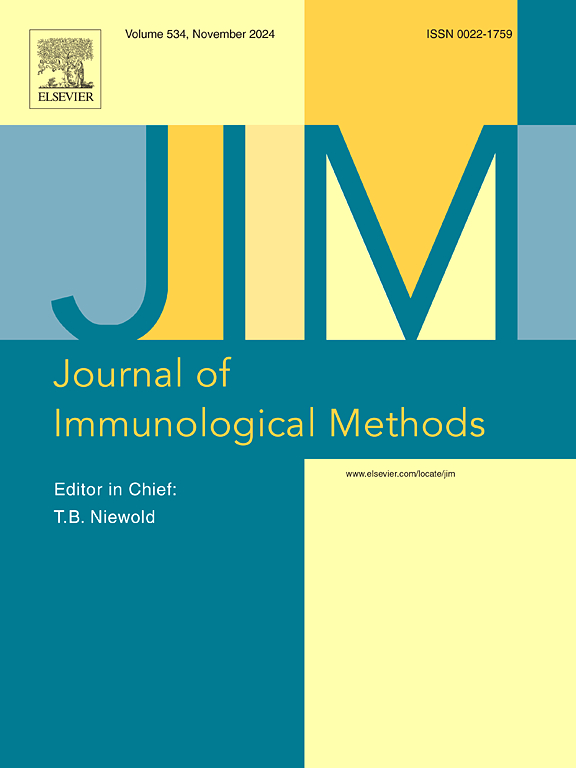用合成肽鉴定牛IgG1 Fc受体(boFcγRI)上的线性Fc结合表位。
IF 1.6
4区 医学
Q4 BIOCHEMICAL RESEARCH METHODS
引用次数: 0
摘要
背景:牛 IgG1 Fc 受体(boFcγRI)是人 FcγRI (CD64)的同源物,具有三个细胞外 Ig 样结构域,能与牛 IgG1 高亲和力结合。鉴定 boFcγRI 上 Fc 结合的线性表位为 IgG-Fcγ 相互作用和 FcγR 靶向药物的开发提供了新的见解:方法:在转染 COS-7 细胞的细胞表面表达 boFcγRI 分子。在大肠杆菌(E. coli)BL21 中表达 boFcγRI 的胞外结构域,并通过镍螯合色谱法纯化可溶性 boFcγRI 后进行重折叠。为了确定 boFcγRI 上的 Fc 结合表位,合成了来自 boFcγRI 膜远端胞外结构域(EC2)的多肽,并将其与不含 IgG 的牛血清白蛋白(BSA)载体蛋白结合。通过点印迹试验检测了牛 IgG1 与不同多肽的结合情况,并通过截短和突变对显示出最大 IgG 结合力的多肽进行了进一步修饰。Fc 结合肽的抑制效果分别通过竞争性酶联免疫吸附试验(Competitive ELISA)和 Fc 漂移抑制试验(Fc-rosetting inhibition assay)进行测定:结果:与 boFcγRI 142-149 序列相对应的最小有效肽 TNLSHNGI 在 Dot-blot 中与牛 IgG1 特异性结合,表明它代表了位于受体 EC2 结构域假定 E-F 环的线性配体结合表位。对该肽的突变分析表明,线性表位中的 Thr142、Asn143、Leu144、Gly148 和 Ile149 残基对 IgG1 结合至关重要。该 Fc 结合肽可抑制牛 IgG1 与 boFcγRII 可溶性重组蛋白的结合,IC50 为 20.27 μmol/L,并可抑制牛 IgG1 致敏 RBC 在 boFcγRI 转染细胞上的莲座形成,IC50 为 86.75 μmol/L:结论:利用合成肽鉴定了boFcγRI上EC2结构域的Fc结合线性表位及其关键残基。该 Fc 结合肽具有良好的调节细胞表面 boFcγRI-IgG1 相互作用的能力。本文章由计算机程序翻译,如有差异,请以英文原文为准。
Identification of the linear Fc-binding epitope on the bovine IgG1 Fc receptor of (boFcγRI) using synthetic peptides
Background
Bovine IgG1 Fc receptor (boFcγRI) is a homologue to human FcγRI (CD64) that has three extracellular Ig-like domains and can bind bovine IgG1 with high affinity. Identification of the linear epitope for Fc-binding on boFcγRI provides new insights for the IgG-Fcγ interaction and FcγR-targeting drugs development.
Methods
The boFcγRI molecules were expressed on cell surface of the boFcγRI -transfected COS-7 cells. The extracellular domain of boFcγRI was expressed in Escherichia coli (E. coli) BL21, and the soluble boFcγRI was purified by Ni-chelation chromatography followed by refolding. To identify the Fc-binding epitope on the boFcγRI, peptides derived from the membrane-distal extracellular domain (EC2) of boFcγRI were synthesized and conjugated to a carrier protein of IgG-free bovine serum albumin (BSA). Binding of bovine IgG1 to the different peptides was tested by Dot-blot assay, and the peptide showing maximal IgG-binding was further modified by truncation and mutation. The inhibition effect of the Fc-binding peptide was determined by competitive ELISA and Fc-rosetting inhibition assay, respectively.
Results
The minimal effective peptide TNLSHNGI corresponding to the sequence 142–149 of boFcγRI was found to bind bovine IgG1 specifically in Dot-blot suggesting it represents a linear ligand-binding epitope located in the putative E-F loop of the EC2 domain on the receptor. Mutation analysis of the peptide showed that the residues of Thr142, Asn143, Leu144, Gly148 and Ile149 within the linear epitope are critical for IgG1-binding. The Fc-binding peptide inhibited bovine IgG1 binding to the soluble recombinant protein of boFcγRII with IC50 of 20.27 μmol/L, and inhibited the rosette formation of bovine IgG1-sensitized RBCs on the boFcγRI transfected cells with IC50 of 86.75 μmol/L.
Conclusions
The linear epitope for Fc-binding as well as its crucial residues of EC2 domain on boFcγRI was identified using synthetic peptides. The Fc-binding peptide showed well capability of regulating boFcγRI-IgG1 interaction on cell surface.
求助全文
通过发布文献求助,成功后即可免费获取论文全文。
去求助
来源期刊
CiteScore
4.10
自引率
0.00%
发文量
120
审稿时长
3 months
期刊介绍:
The Journal of Immunological Methods is devoted to covering techniques for: (1) Quantitating and detecting antibodies and/or antigens. (2) Purifying immunoglobulins, lymphokines and other molecules of the immune system. (3) Isolating antigens and other substances important in immunological processes. (4) Labelling antigens and antibodies. (5) Localizing antigens and/or antibodies in tissues and cells. (6) Detecting, and fractionating immunocompetent cells. (7) Assaying for cellular immunity. (8) Documenting cell-cell interactions. (9) Initiating immunity and unresponsiveness. (10) Transplanting tissues. (11) Studying items closely related to immunity such as complement, reticuloendothelial system and others. (12) Molecular techniques for studying immune cells and their receptors. (13) Imaging of the immune system. (14) Methods for production or their fragments in eukaryotic and prokaryotic cells.
In addition the journal will publish articles on novel methods for analysing the organization, structure and expression of genes for immunologically important molecules such as immunoglobulins, T cell receptors and accessory molecules involved in antigen recognition, processing and presentation. Submitted full length manuscripts should describe new methods of broad applicability to immunology and not simply the application of an established method to a particular substance - although papers describing such applications may be considered for publication as a short Technical Note. Review articles will also be published by the Journal of Immunological Methods. In general these manuscripts are by solicitation however anyone interested in submitting a review can contact the Reviews Editor and provide an outline of the proposed review.

 求助内容:
求助内容: 应助结果提醒方式:
应助结果提醒方式:


